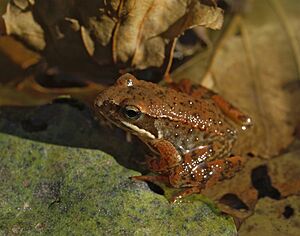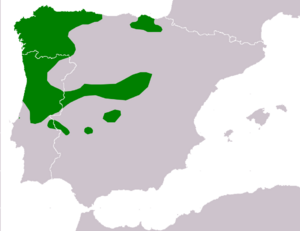Iberian frog facts for kids
The Iberian frog (Rana iberica) is a type of frog that lives in Portugal and Spain. It's also called the Iberian stream frog because it loves to live near rivers, mountain streams, and swamps. Sadly, this frog is facing threats like losing its home, new animals moving into its area, changes in the weather, dirty water, and too much sunlight.
Quick facts for kids Iberian frog |
|
|---|---|
 |
|
| Conservation status | |
| Scientific classification | |
 |
Contents
About the Iberian Frog
The Iberian frog can grow to about 7 cm (2.8 in) long. However, most are usually around 5 cm (2.0 in). Female frogs are often bigger than males.
What They Look Like
You can see a round patch behind the frog's eye. This is called the tympanum, which is like its eardrum. It's about half the size of its eye. A clear ridge, called the dorsolateral fold, runs from the side of its head to its back legs. This helps tell it apart from the common frog.
The frog's skin is smooth and has tiny bumps. Its color can change a lot. It might be olive green, reddish, or grayish-brown. Sometimes it has darker spots or patterns. A dark line goes from its nose to its eye. A thin, white line is also visible on its upper lip. Its back legs sometimes have dark brown stripes. The webbing on its back feet is more complete than that of the common frog. The frog's belly is light-colored, sometimes with darker spots. However, the middle of its throat is usually plain.
What They Sound Like
The Iberian frog has a special call. It usually makes this sound at night. It sounds like "rao-rao-rao." It calls about three times every second.
Where They Live
The Iberian frog lives only in Portugal and parts of Spain. This means it is endemic to these areas. It is a mountain animal and has been found as high as 2,425 m (7,956 ft).
Their Home
In Portugal, it lives in the northern half of the country. In Spain, you can find it in Galicia, western León, and northwestern Zamora. There are also separate groups in the mountains of central Spain. These frogs like slow-moving streams and rivers with plants hanging over the water. They also live in ponds and lakes formed by glaciers.
The Iberian frog shares its home with other frogs. These include the agile frog (Rana dalmatina), Perez's frog (P. perezi), and the common frog (R. temporaria).
Life Cycle and Habits
The Iberian frog is very quick. If it feels in danger, it will jump into the water and swim away fast. It is active both during the day and at night.
What They Eat
These frogs eat many different insects and other small creatures. Their diet includes beetles, flies, caddisflies, stoneflies, spiders, and harvestmen.
Reproduction
In Galicia and lowland Portugal, Iberian frogs breed from November to March. But in higher mountain areas, they breed later, from March to May. During breeding, the male frog holds onto the female's back in the water. This is called amplexus.
The female lays small groups of eggs. These eggs have a jelly-like coating. They are often stuck to water plants or placed under rocks in the water. When the tadpoles hatch, they eat plants. It takes about three months for them to change into young frogs. These young frogs are about 1.3 cm (0.5 in) long. Males can start having babies when they are about 3 cm (1.2 in) long. Females need to be a bit larger to become mature.
Protecting the Iberian Frog
The Iberian frog is facing many dangers. Its home is being lost because of farming, cutting down forests, and planting trees that are not native to the area. Building for tourists and people using the land for fun can also disturb the frogs.
Threats to Their Survival
New types of fish that are not from the area can also harm the frogs. The American mink (Neogale vison), which sometimes escapes from fur farms, also preys on them. These things can cause the number of Iberian frogs to go down.
Conservation Efforts
Some parts of the frog's home are protected. These include two national parks: Parque Natural del Gorbea and Parque Natural de Izki. In these parks, the frogs are safe. However, in other places, like the Sistema Central Mountains and Extremadura in Spain, the frog populations are getting smaller. Because of these threats, the Iberian frog is listed as a "vulnerable" species on the IUCN Red List of Threatened Species. This means it is at risk of becoming endangered.


